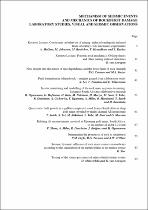 ResearchSpace
ResearchSpace
Relating tilt measurements recorded at Mponeng Gold Mine, South Africa to the rupture of an M 2.2 event
JavaScript is disabled for your browser. Some features of this site may not work without it.
- ResearchSpace
- →
- Research Publications/Outputs
- →
- Conference Publications
- →
- View Item
| dc.contributor.author |
Share, P

|
|
| dc.contributor.author |
Milev, A

|
|
| dc.contributor.author |
Durrheim, R

|
|
| dc.contributor.author |
Kuijpers, J

|
|
| dc.contributor.author |
Ogasawara, H

|
|
| dc.date.accessioned | 2014-02-13T08:57:01Z | |
| dc.date.available | 2014-02-13T08:57:01Z | |
| dc.date.issued | 2013-09 | |
| dc.identifier.citation | Share, P, Milev, A, Durrheim, R, Kuijpers, J and Ogasawara, H. 2013. Relating tilt measurements recorded at Mponeng Gold Mine, South Africa to the rupture of an M 2.2 event. In: Proceedings of the Eighth International Symposium on Rockbursts and Seismicity in Mines, Saint Petersburg, Moscow, 1-7 September 2013 | en_US |
| dc.identifier.isbn | 978-5-903258-28-4 | |
| dc.identifier.uri | http://hdl.handle.net/10204/7203 | |
| dc.description | Proceedings of the Eighth International Symposium on Rockbursts and Seismicity in Mines, Saint Petersburg, Moscow, 1-7 September 2013 | en_US |
| dc.description.abstract | High resolution tiltmeters were installed during 2007 at Mponeng gold mine, South Africa, in an attempt to study and understand the risks posed by in-mine seismic events and to subsequently use the knowledge gained to mitigate the said risks. In December 2007, an M 2.2 event occurred at Mponeng and was detected by the tiltmeters installed. The tilt expected for the M 2.2 event is modelled through the use of numerical and analytical tools and utilizing, as input parameters, characteristics of the event such as the rupture area, the amount of slip, elastic properties of the rock, the state of stress before the event occurred and frictional parameters of the rupture. The calculated tilt values are correlated and compared with the recorded data, and are found to be of the same order. Certain input parameters, such as the initial rupture point, are further constrained by varying them, during modelling, until the calculated and observed tilt values are approximately equal. From modelling, it can be concluded that the rupture point had to be closer to the location of the tiltmeters. In addition, possible locations acting as source areas for the observed aftertilt are determined. These conclusions aside, further modelling needs to be done to quantify the effects of the tunnel close to the tiltmeters and plastic deformation of the rockmass. | en_US |
| dc.language.iso | en | en_US |
| dc.relation.ispartofseries | Workflow;11745 | |
| dc.subject | Mponeng Gold Mine | en_US |
| dc.subject | High-resolution tilt measurements | en_US |
| dc.subject | Rockbursts | en_US |
| dc.subject | Mining-indices seismicity | en_US |
| dc.subject | Deep-level mining | en_US |
| dc.subject | Japan South African research | en_US |
| dc.title | Relating tilt measurements recorded at Mponeng Gold Mine, South Africa to the rupture of an M 2.2 event | en_US |
| dc.type | Conference Presentation | en_US |
| dc.identifier.apacitation | Share, P., Milev, A., Durrheim, R., Kuijpers, J., & Ogasawara, H. (2013). Relating tilt measurements recorded at Mponeng Gold Mine, South Africa to the rupture of an M 2.2 event. http://hdl.handle.net/10204/7203 | en_ZA |
| dc.identifier.chicagocitation | Share, P, A Milev, R Durrheim, J Kuijpers, and H Ogasawara. "Relating tilt measurements recorded at Mponeng Gold Mine, South Africa to the rupture of an M 2.2 event." (2013): http://hdl.handle.net/10204/7203 | en_ZA |
| dc.identifier.vancouvercitation | Share P, Milev A, Durrheim R, Kuijpers J, Ogasawara H, Relating tilt measurements recorded at Mponeng Gold Mine, South Africa to the rupture of an M 2.2 event; 2013. http://hdl.handle.net/10204/7203 . | en_ZA |
| dc.identifier.ris | TY - Conference Presentation AU - Share, P AU - Milev, A AU - Durrheim, R AU - Kuijpers, J AU - Ogasawara, H AB - High resolution tiltmeters were installed during 2007 at Mponeng gold mine, South Africa, in an attempt to study and understand the risks posed by in-mine seismic events and to subsequently use the knowledge gained to mitigate the said risks. In December 2007, an M 2.2 event occurred at Mponeng and was detected by the tiltmeters installed. The tilt expected for the M 2.2 event is modelled through the use of numerical and analytical tools and utilizing, as input parameters, characteristics of the event such as the rupture area, the amount of slip, elastic properties of the rock, the state of stress before the event occurred and frictional parameters of the rupture. The calculated tilt values are correlated and compared with the recorded data, and are found to be of the same order. Certain input parameters, such as the initial rupture point, are further constrained by varying them, during modelling, until the calculated and observed tilt values are approximately equal. From modelling, it can be concluded that the rupture point had to be closer to the location of the tiltmeters. In addition, possible locations acting as source areas for the observed aftertilt are determined. These conclusions aside, further modelling needs to be done to quantify the effects of the tunnel close to the tiltmeters and plastic deformation of the rockmass. DA - 2013-09 DB - ResearchSpace DP - CSIR KW - Mponeng Gold Mine KW - High-resolution tilt measurements KW - Rockbursts KW - Mining-indices seismicity KW - Deep-level mining KW - Japan South African research LK - https://researchspace.csir.co.za PY - 2013 SM - 978-5-903258-28-4 T1 - Relating tilt measurements recorded at Mponeng Gold Mine, South Africa to the rupture of an M 2.2 event TI - Relating tilt measurements recorded at Mponeng Gold Mine, South Africa to the rupture of an M 2.2 event UR - http://hdl.handle.net/10204/7203 ER - | en_ZA |





